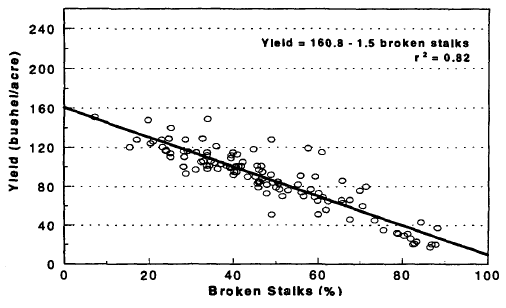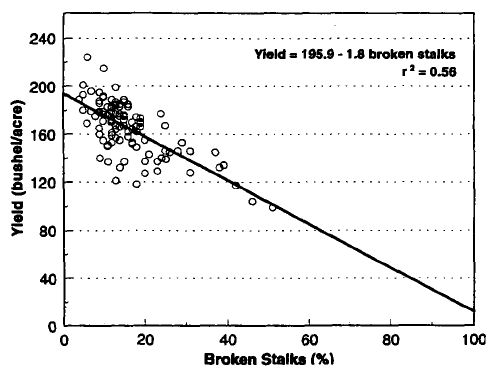July 11, 2011
Field Crops 28.49
- 86
Yield Response of Flattened (Lodged) Corn
Joe Lauer, Corn Agronomist
Last night,
July 11, a storm rolled through southern Wisconsin and northern
Illinois causing corn to flatten (lodge) in the field. Lodged corn can
be seen in a 30-50 mile east-west swath from Grant County to well into Walworth
County. It is unclear yet, as to whether entire stalks lodged or
whether stalk breakage (greensnap) has occurred. Most likely it is stalk
lodging. All hybrids (conventional and transgenic seem to be affected
equally). Most plants did not have brace roots yet. We will
review yield data for both situations.
Wind lodging
Corn root lodging often occurs during the mid-growing season,
when soils are saturated by heavy rainfall and the rainfall is
accompanied or followed by high wind speeds. Often, entire corn stands are blown
down. Initially, producers are
concerned about how much recovery they can expect and potential
losses from mechanical harvesting root-lodged corn. After a few
days, the plants usually grow upward so that the upper stalk
is vertical, but curvature occurs in the lower stalk area. Grain
yield losses in conjunction with lodging can be attributed to
(i) inhibited uptake and translocation of nutrients, primarily
when lower-stalk breakage occurred; and (ii) reduced light
interception, despite lack of any apparent stem injury. Wind
lodging of corn is most likely to occur when plants are in
mid-vegetative stages, and have not yet developed adequate brace
roots.
Carter and Hudelson (1988) simulated root lodging due to wind in
a field experiment by saturating the soil with irrigation water
and manually pushing corn plants over at the base, perpendicular
to row direction. Treatments applied were a control and
simulated wind lodging at V10, V13 to V14, and V17 to R1 stages
in 1985 and V11 to V12, V15, and VT stages in 1986. Three
hybrids were included. The upper region of plants straightened
to vertical within two days following lodging, and lodging did
not affect subsequent timing of plant development. The angle
between the below-ear stalk and soil surface at harvest
decreased from 73 to 85° with lodging at early (V10-V12) stages
to 22 to 36 ° at late (V17-R1) stages due to more pronounced
lower stalk curvature. This resulted in ear height reductions
from 52 to 57 in. for controls to less than 30 in. when lodging
occurred after V17. These results indicate that mechanical
harvest of corn wind lodged during V10 to R1 stages will likely
be possible, but slow harvest speeds may be necessary to
minimize losses. Compared to hand-harvested grain yields of
control plots, grain yield decreased (Table 1).
| Table 1. Influence of
simulated wind lodging on corn grain yield |
| ISU Growth Stage |
Grain yield decrease |
| |
% |
| V10 - V12 |
2 - 6 |
| V13 - V15 |
5 - 15 |
| V17 - R1 |
13-31 |
| derived from Carter and Hudelson, 1988 |
Stalk breakage
Rapidly growing corn is more susceptible to stalk breakage from
wind as well as other physical phenomenon such as cultivation,
hilling, or fertilizer application where stalks are bent by a
low tool bar. Mid-season stalk breakage is a type of stem
lodging also referred to as "greensnap" or "brittle snap." This
typically occurs a few nodes above the soil surface, at or below
the primary ear node and usually occurs when stalks are moist
and turgid. In general, treatments that cause plants to grow more
rapidly enhanced susceptibility to stalk breakage (Wilhelm et
al., 1999). Row direction, as well as planting dates and other
cultural practices, have varying impacts on a crop's ability to
withstand the wind. Corn plant displacement by wind (regardless of
wind direction) was greater perpendicular to the row direction
than parallel to the row direction (Flesch and Grant, 1992).
Elmore and Ferguson (1999) measured mid-season corn stalk
breakage on over 100 hybrids in south central Nebraska resulted
from 100 mph winds on 8 July 1993 and 80 mph winds on 1 July
1994. Corn growth stages at the time of damage ranged from V10
to V14. In 1993 stalk breakage ranged from 7 to 88%, and grain
yield was reduced 1.5 bu/acre for every 1% increase in stalk
breakage. Breakage in 1994 ranged from 1 to 37% at one site and
from 5 to 51% at the other site. Grain yield was reduced by 1.5
and 1.8 bu/acre for every 1% increase in stalk breakage.
Remaining plants did not compensate for grain loss from broken
plants at any site. Percentage yield loss is directly related to
percentage stalk breakage.
1993

1994

Figure 1. The effect of stalk breakage on grain yield in
Nebraska in 1993 and 1994.
Using Foliar Fungicides
I was unable to find any data related to the need for foliar
fungicides on lodged corn. The closest data was corn response to
hail damage. Hail damage likely causes more problems than wind
lodging due to bruising of leaves and stems.
Fungicide application cannot recover yield potential lost due to
damage. Fungicides protect yield potential by reducing
disease. There are some diseases of corn that are favored by
wounding, e.g., Goss's wilt, common smut and stalk rot, but
fungicides are not effective against the pathogens. The foliar
diseases managed by fungicides (e.g., gray leaf spot, northern
corn leaf blight, eye spot, and common rust on corn, and brown
spot and frog eye on soybeans) are caused by pathogens that do
not require wounds for infection.
A simulated hail-fungicide trial was conducted at Urbana in
2007, with corn plants being damaged with a string trimmer just
before tasseling to simulate hail damage (Bradley and Ames, 2010). Some
plots were left undamaged as well. The fungicides Headline, Quadris, and Quilt were applied to the plots and compared to an
untreated check. When the data were statistically analyzed,
fungicides did not significantly improve yield compared to the
untreated check in the "hail-damaged" plots or the nondamaged
plots (Table 2). The simulated hail damage alone did decrease
yield by approximately 30 bu/A compared to the nondamaged plots,
however.
Table 2. Effect of simulated hail damage and foliar fungicides
applied at tassel emergence on gray leaf spot severity and yield
of
a susceptible corn hybrid near Champaign, Illinois, in 2007.
(Bradley and Ames, 2008.
Foliar Fungicides in Corn Production:
A
Look at Local and Regional Data. Proceedings of the 2008
Illinois Crop Protection Technology Conference. ) |
| Simulated Hail 1 |
Fungicide |
Rate/Acre |
GLS Severity 2 |
Yield (bu/ac) |
| No |
Untreated |
|
57 |
174 |
| |
Headline® |
6 fl oz |
33 |
179 |
| |
Quadris® |
6 fl oz |
42 |
170 |
| |
Quilt® |
14 fl oz |
40 |
155 |
| Yes |
Untreated |
|
62 |
141 |
| |
Headline ® |
6 fl oz |
48 |
144 |
| |
Quadris® |
6 fl oz |
47 |
142 |
| |
Quilt® |
14 fl oz |
35 |
140 |
| |
LSD 3 |
|
12 |
11 |
1 Hail was simulated by damaging corn plants with a weed-eater
type string mower.
2 Gray leaf spot severity (0-100% scale).
3 Fisher's protected least significant difference (P = 0.05).
|
Fungicides should be used as a "tool" (along with other IPM
practices) – to control diseases that are present and/or almost
certain to be a problem. Consider the following factors before
spraying:
- hybrid susceptibility,
- disease pressure at VT,
- weather conditions at VT and during grain fill,
- previous crop,
- the amount of crop residue present in the field,
- fungicide and application cost ,
- grain price, and
- read directions and restrictions on product label.
In general, a fungicide application is not recommended on
resistant hybrids. On susceptible hybrids, a fungicide
application may be warranted if disease is present on the third
leaf below the ear leaf or higher on 50 percent of the plants at
tasseling. With intermediate hybrids, a fungicide need only be
applied if conditions are favorable for disease development.
Spray if disease is present on the third leaf below the ear leaf
or higher on 50 percent of the plants at tasseling, and the
weather is warm and humid, and the field has a history of Gray
Leaf Spot and/or Anthracnose, and >35 percent corn residue is
present.
What do we do now?
Be patient. Let the corn crop recover. Make notes about
hybrid differences for lodging resistance, crop development and
whether brace roots had formed. Watch lodged fields closely,
especially later near harvest. Plan on harvest taking slightly
longer and expect 5-15% lower grain yields.
Key References
Bradley, C.A., and K.A. Ames. 2010. Effect of Foliar Fungicides
on Corn with Simulated Hail Damage. Plant Disease 94:83-86. DOI:
doi:10.1094/PDIS-94-1-0083.
Carter, P.R., and K.D. Hudelson. 1988. Influence of simulated
wind lodging on corn growth and grain yield. J. Prod. Agric.
1:295-299.
Elmore, R.W., and R.B. Ferguson. 1999. Mid-season stalk breakage
in corn: hybrid and environmental factors. J. Prod. Agric.
12:293-299.
Flesch, T.A., and R.H. Grant. 1992. Corn motion in the wind
during senescence. I. motion characteristics. Agron J
84:742-747.
Wilhelm, W.W., M.A. Liebig, G.E. Varvel, and T.M. Blackmer.
1999. Midseason stalk breakage in corn as affected by crop
rotation, hybrid, and nitrogen fertilizer rate. Agron J
91:160-165.